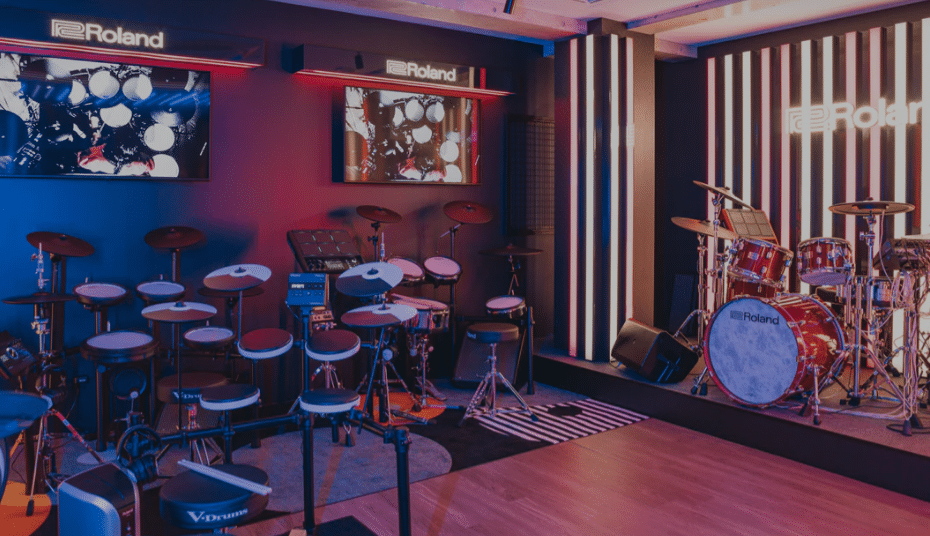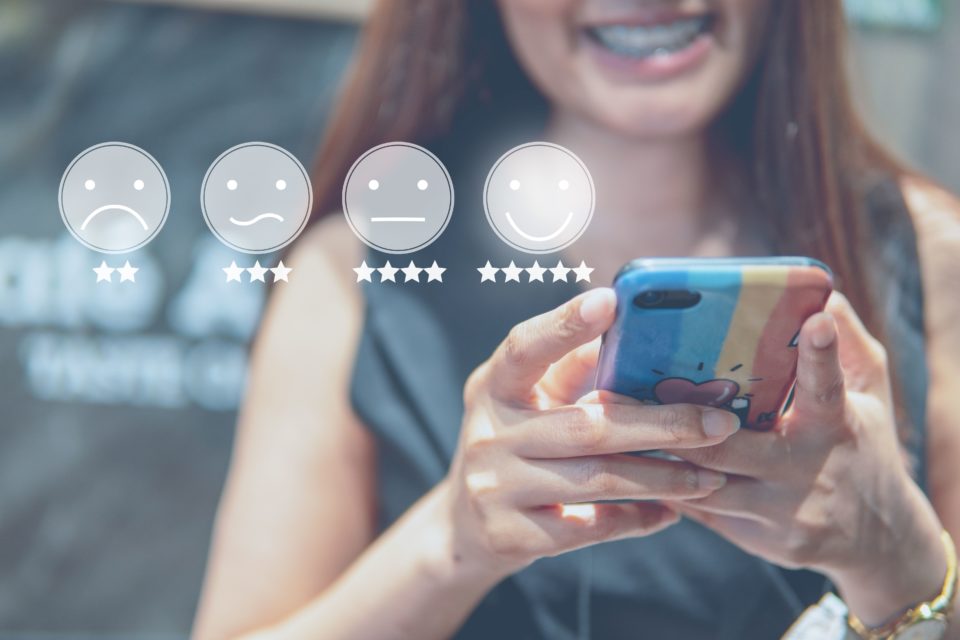Stores run by bots? Why Spruce sees retail tech as an enabler of experience
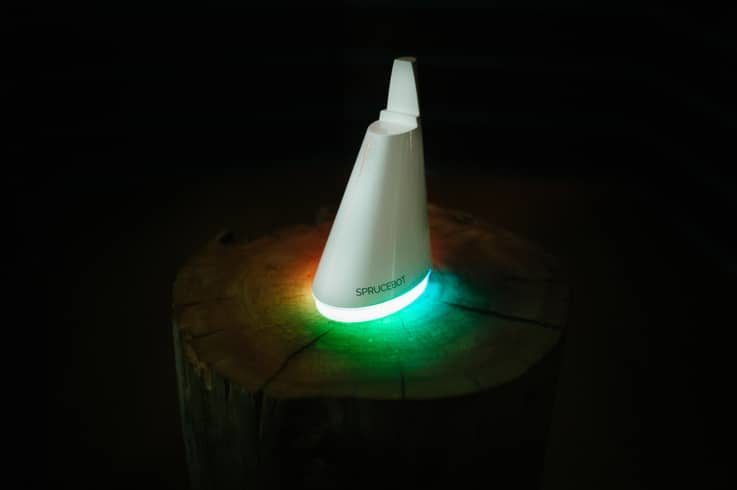
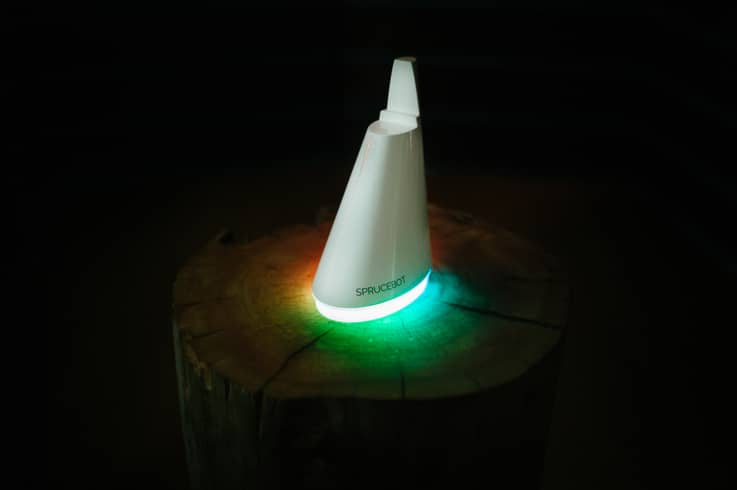
How do you feel about technology in stores? Do you see it as enhancing the customer experience or taking away from it? What if the technology is invisible?
From the outside, Spruce doesn’t look like a game-changer. But this boutique, barber and style consultancy is actually run by a bot – not that the customers would know. The Sprucebot makes sure staff remember every customer, enables guests to make bookings and provide feedback, and so much more.
Now Spruce is branching out into offering the Sprucebot to other retailers looking to provide a better customer experience, without taking away the human interaction. Co-founder Taylor Romero explains what inspired the bot, what makes retail tech succeed or fail, and why he thinks Amazon won’t succeed in physical retail without some changes:
Can you explain Spruce in a nutshell?
We’re an organisation that focuses first and foremost on experience. Regardless of the medium or environment, I want people to walk out of a store and go ‘that was the answer and I didn’t even know what I was asking’. You get the right experience and you interact with the right product, even if you didn’t know that you needed it or wanted it, you know when you enjoyed it and want to do it again.
Sprucebot is medium agnostic, so spans retail and casual leisure and entertainment. The reason why there’s so much focus on retail is that the fully immersive experience that you get when you’re shopping is really the big differentiator between physical and digital retail. And if Spruce were to try to compete on price or convenience we’d fail – it’s way better to get something from Amazon if you just want something to your door.
But if you’re feeling down and you want to go into an environment where you’re going to get a pick-me-up, a little jolt of social energy, coming to Spruce is the perfect remedy. You will never get done shopping at Amazon and feel like ‘wow my day just got way better, I’m ready to take on the world.’
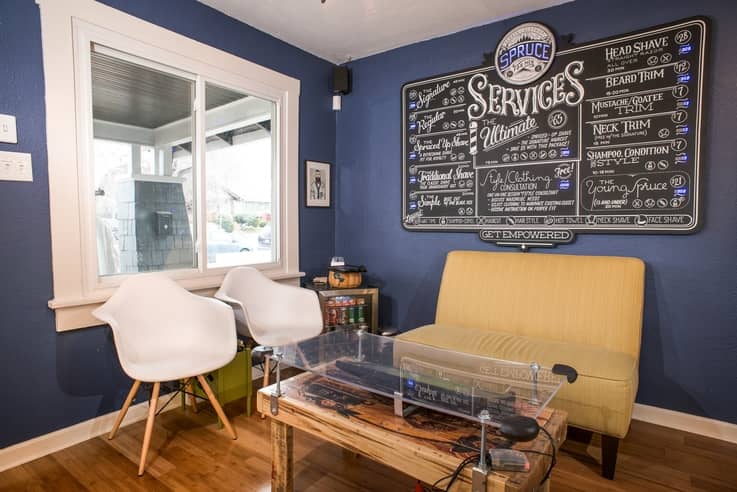
So Amazon is about function and Spruce is about experience?
One thing people mess up a lot is they see processes and say we can automate that.
A perfect example is when I went to Amazon Books. Amazon’s brought a lot of its strengths to Books around inventory management, logistics – essentially it all comes down to getting the right book in the store at the right time. They have good actionable data, so they can provide a very relevant book buying opportunity.
Amazon’s culture is very focused on automation and scale. The problem that they ran into with Amazon Books is not only did they take all the things they thought were good about the back-end, but they took all the good things about retail and removed them and tried to automate them. Essentially what you end up doing is walking into a store that has no pricing, where everyone is holding their phone looking things up.
Amazon has zero concept about the things that make retail strong and it is so counter to Amazon’s culture to put people where they could put a machine that Amazon doesn’t stand too much of a chance in retail unless they purchase someone who already understands the value of the experience. The one way Amazon could wreck Whole Foods, as far as the brand that we’ve come to know, is by automating in-store experience. We don’t go to Whole Foods to fill a basket, we go to Whole Foods for a lot more than that.
When we look at different situations in retail or out of retail, we don’t actually look at this in terms of ‘can this be automated?’ We look at what part of that didn’t I like and if there are parts of it I didn’t like, those are the parts that we’re going to push off to machines or we’re going to automate. There are certain aspects to retail that are not efficient but we have no intent in automating or replacing them because it’s automating that beer in hand, hanging out and trying on pants that 45 minutes to an hour that would destroy what makes Spruce in particular special
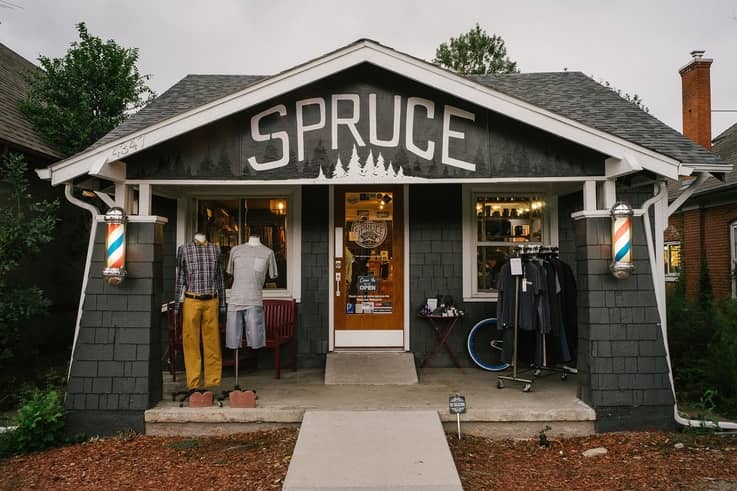
How long has the store been around? And did the store lead to the bot?
About four years ago my wife comes up to me and says ‘after seeing how much you enjoy technology I’ve decided I don’t really enjoy technology. I don’t want to do technology stuff anymore.’ At the time she was working at a digital ad agency downtown.
So I said ‘Ok cool. What do you want to do?’ and she said ‘I want to open a boutique’ and I said ‘that’s not what I was expecting you to say.’ It actually took about a year and half to two years before we opened in June 2015. In the off hours and on weekends I started just building software and technology around a lot of the pain points that I personally experience in a retail setting. Then when we opened I found out I was right about a few things, wrong about a lot of things.
I was working out of the basement of my wife’s shop, just observing the behaviour of the guest and observing the interactions with them and the team to build new features and new abilities, automating new processes, bit-by-bit, piece-by-piece until eventually we started to realise that this Sprucebot was running our store. Everything from faciliating communication to helping keep relevant information about a guest ready and at hand so we can personalise the experience, running reports – it just kept going.
What would happen is other store owners around the area would start to come in and ask if they could use it. And here’s what’s funny. This Sprucebot was never supposed to be Sprucebot, we actually held a vote to see who could come up with the best name and every name sucked. So I put bot after the name of my wife’s store so we could move on and come back, but we never got time to go back.
We really personify Sprucebot. We say if Sprucebot a human, he’d be fresh out of college, he’d be trying way too hard, he’d be super excited to help and he’d be really hard on himself when he messes up. That personality carries through for the whole system. So if the website goes down the error message that pops up says ‘Hey Sprucebot here, I’m so sorry. I have one job, run the website, I can’t even do that. I’m going to go tell the human’s at the shop to get it fixed because I’m a dumb robot.’
When you’re texting with him and he doesn’t understand things he’ll be like ‘Hey I’m sorry I’m not that smart. Would you like me to get a human so you can talk to someone who can actually help you?’ It’s funny because by giving him this personality guests come in and talk about Sprucebot like they know him. But Sprucebot was made for very specific purposes around automating the store and augmenting the team and creating these experiences, so if you try to do something with Sprucebot outside of that he’s just going to tell you ‘I’m not trained for this’.
How long was the store operating without the bot?
Zero. It was not nearly what it is today at all but we never went into this without being augmented by a digital assistant. We were opening the business and it was like ‘let’s at least solve these problems’ and for the next year and a half it was add on add on.
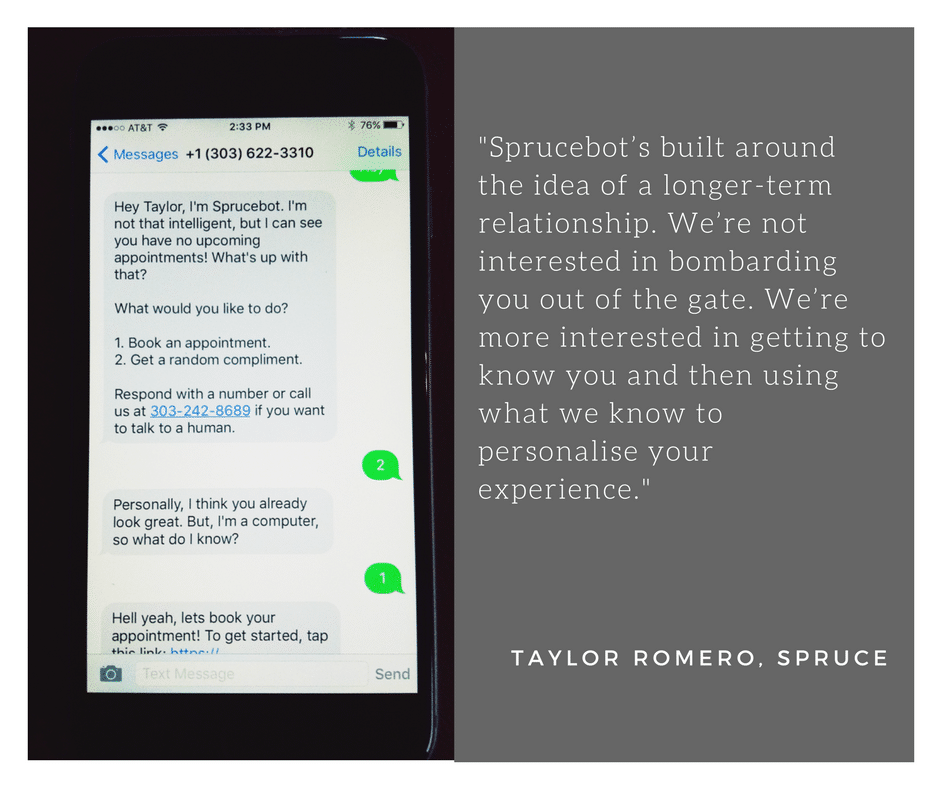
Can you tell me a bit more about the tech behind Sprucebot?
All of it is custom built. It was myself and a few very smart friends working every spare moment we could find. The hardware component is built for in-store deployment, just like Alexa where it sits in your home but that’s really just a microphone to Alexa. It’s kind of the same thing with Sprucebot. When you install Sprucebot in your store you’ll interact with him through different medium, but the physical Sprucebot will essentially forward you on to the Sprucebot that sits in the cloud.
It’s not a chatbot. It has a chat functionality, but very geared towards the things that enhance the guest experience. You can’t sit and have a conversation with him. But you can book an appointment for the barber or the style consultant, leave feedback, get reminders etc. The thing that really makes Sprucebot powerful is that a majority of his interactions are not with the guest, but with the team.
So here’s a scenario around buying a gift for somebody. The Amazon-style approach would be you buy me a gift card and I get a push notification on my phone. I open up the Amazon app, I redeem it and then I’d go into the Amazon Book store and I’d spend it. The way Sprucebot works is I would be in the store and buy you a gift card. Then if you walked into the store, the fact that I’d bought you a gift card will be communicated not to you, but to the team. At which point the team will say ‘Welcome to the store. Here’s the gift card that your friend got you.’
This is a perfect example of where Amazon would think ‘look at all these things we could automate’. And we think ‘someone welcoming me and handing me a gift card is not a process that you need to take away. That’s kind of an enjoyable process.’ So we automate all the pieces around that and the whole time you would have no idea that Sprucebot is notifying the team that you’re arrived, any notes about you, that I bought you a gift card. For you it is magic, you don’t even know there is technology.
We use all these systems not because we’re trying to cheat on our relationship, it’s just that we see hundreds of thousands of people and we can’t remember everybody. So after a guest leaves Sprucebot follows up with the team to take notes, so that the information you need in the profile of the guest is sent right to you when they arrive, and you download it from your brain when they leave.
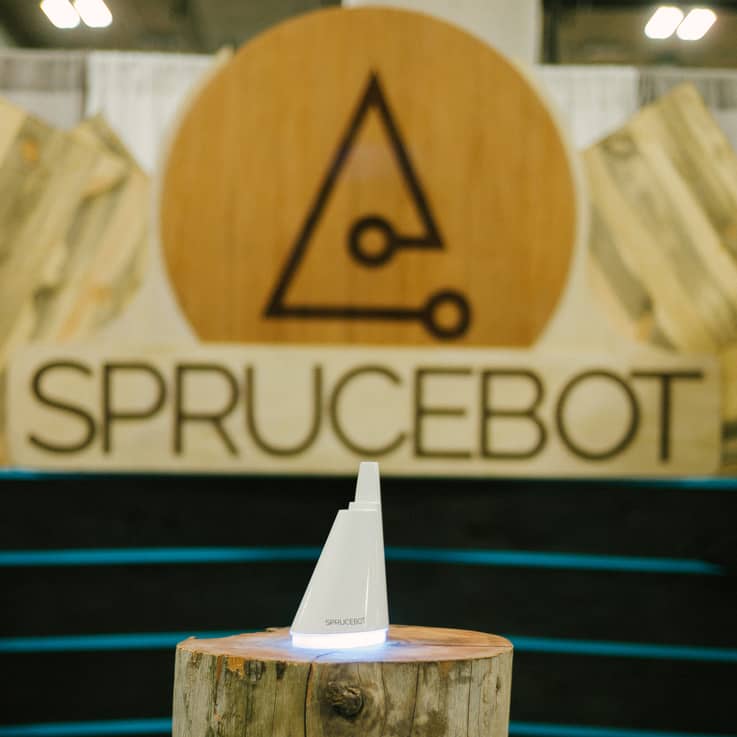
What does someone have to do beforehand for the team to know about them before they arrive?
I think a good way to look at it is when you visit a website unauthenticated there’s still the log-in. It has no idea who you are. There’s a big potential creepy factor to this, so on your first visit if you’ve not interacted with Sprucebot at all then we don’t know who you are. That can be in-store, Facebook, web, text etc. And at any time you can opt out and Sprucebot will forget who you are.
We’re very privacy friendly. We don’t do any tracking of you, unless you opt-in we can’t use any of these systems. That’s less a limitation of the tech and more of our promise to protect privacy. We don’t have any forcing factors. You can be off the grid. That’s a big difference to someone like Amazon who is mostly concerned about scale and getting you into their scalable system.
Retail is not a one-and-done. Generally if you live in a neighbourhood and there are stores, unless you did not like the experience you’ll go back to those stores. So Sprucebot’s built around the idea of a longer-term relationship. We’re not interested in bombarding you out of the gate. We’re more interested in getting to know you and then using what we know to personalise your experience.
Think about how annoying is it to fill out forms or answer questions. When you initially interact with Sprucebot we don’t even ask you your name. Your name defaults to friend. Over time that profile gets built up and that might be over one visit or over five. It depends on you and the interaction with the team.
There is such a human component to this that we have our best practices. If you come in I’ll ask you your name and where you’re from or how you’re doing or what you’re looking for. If you don’t want to be talked to we won’t push it. Everybody’s profile is a little bit different, some partially completed, fully completed, not at all completed. The notes make each profile unique and relevant.
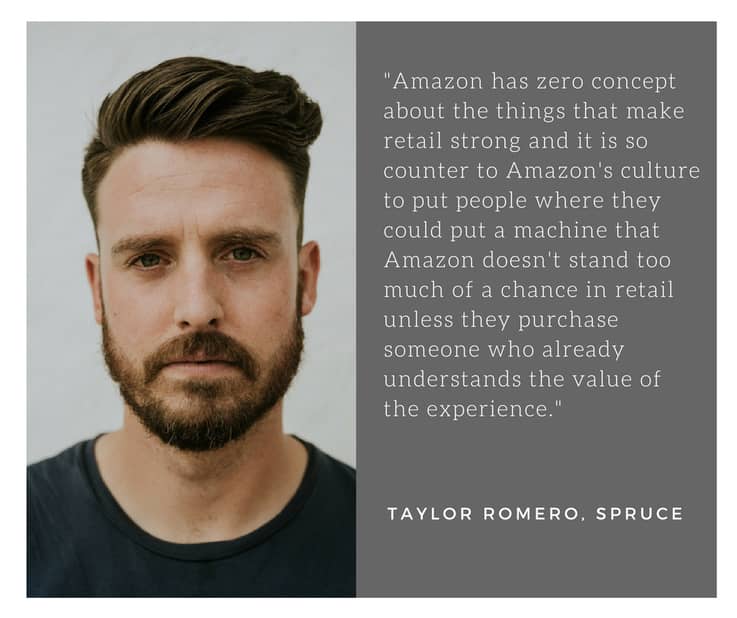
If a customer doesn’t visit for a while, does Sprucebot ever reach out to them?
No. We have a rule with Sprucebot – no outbound marketing. And the reason why we do that is that the information that Sprucebot has and the means of communicating are all so personal that we don’t want to be the organisation known for ruining those communication methods.
Because we are talking to business owners we know that a lot of them want more marketing and we tell them ‘look we’re not a marketing platform. If you want to do outbound marketing there are a thousand and one options, all of them terrible.’
They’re all terrible as having been a retail guest in many a place I have never stayed subscribed to anybody’s mailing list. Most times I don’t even opt-in. What’s happening is a lot of technology companies are taking the mechanics that work on the Internet and trying to apply them to retail. ‘Give them the opt in and then we’ll hit them once a month, and then twice a week, and then after 30 days we’ll do this. But if you’d just say ‘Hey Taylor’ when I walked back into the store I’d be back.’
How does the team get the information from Sprucebot?
It works with every interface. We want you to use the interface that you will actually use and for most people we find that’s text or the web. In-store we generally use apps for real-time notifications.
We also have tablets that go into different modes, so store mode where I can see everybody who’s in with a tap. We even place tablets and phone screens in very specific places in the store based on the behaviour of the team. So instead of coming in and being ‘like this is a good spot for an iPad’, we prefer to sit and wait and see where the team naturally congregates. Then we’ll put the tablet there. The idea is that the more behaviour that you have to change, the more you’re going to push back adopting it.
How do you know that the team is going to interpret this customer information in the right way?
Everybody engages at their own level. One thing that Sprucebot does is he follows up 24 hours after your first visit and asks ‘please tell me one thing I could do better’.
That message gets broadcast to everybody on the team, so everybody knows how everybody is performing. We leverage social pressure to motivate versus monetary or punishment based incentives. It’s kind of a contest to create the best experience. Sprucebot works to cultivate that culture but we don’t aggregate your score. Nobody’s got a user experience score.
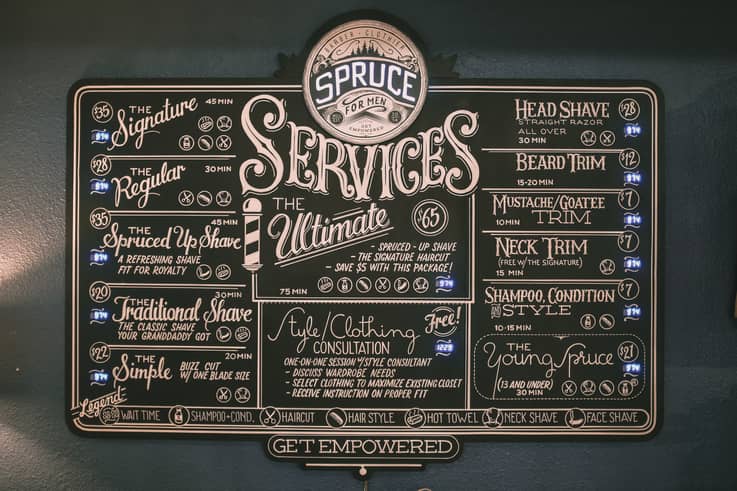
Can you tell me about the handshake check-out?
It’s really not magic. You essentially save your card with Sprucebot and then the point-of-sale pings Sprucebot and say ‘charge this guest for this amount’ and will run your card and text you confirmation and a receipt.
The team member still has to use the point-of-sale to press the handshake checkout button. The way that we’ve built it is it’s actually a very minor behaviour change for the team as well. One struggle we had with things like beacons is that nobody would go replace the batteries. You don’t think about things like this. You’ve got to have people on your team to maintain tech and we’re a small shop. The majority of retailers in America are not equipped or prepared to do anything with beacons because it’s just too much to ask.
Do you still have beacons in the store?
No. We tried everything. It was very obvious when certain things would and would not work. Generally what we found is that the more we asked of the team the less chance there was that it got done. This is where a lot of retail tech companies are missing the mark hugely. The retail force is made up in a big part of people of a younger generation. The best way to get them to use the tech is to make it as easy to use as Snapchat or Facebook.
High-end retailers are definitely a different niche. I was talking to the CEO of Louis Vuitton North America and he said ‘any good sales rep can do all the things you’re talking about.’ But I’m talking about a $10/hour millennial who’s totally disinterested in the mission of their company.
So we had to scrap every bit of tech that required maintenance. And when we did that we realised we can scale this because there’s no instructions now, we took out all the maintenance. You have to install that physical bot unit in your store and then you can walk away.
Is there a cost to access the Sprucebot system?
Right now we’re working on pricing, but it would be a one-time payment for the bot. You get the unit and then you add on skills and we’re creating a skills marketplace. Because of the nature of Sprucebot, it’s hyper local and with the curation that we’re going to do around the skills that we’re going to make available, we think there’s potential for people who get into retail to build a skill to help themselves, to release it to other people and have an entirely new revenue stream.
Our target right now is a 14 year old, for the level of complexity around the interface. So there’s a lot of complex stuff that we’re hiding from you, but you should be able to, with a few commands, get a skill up and running and get it tested in your store.
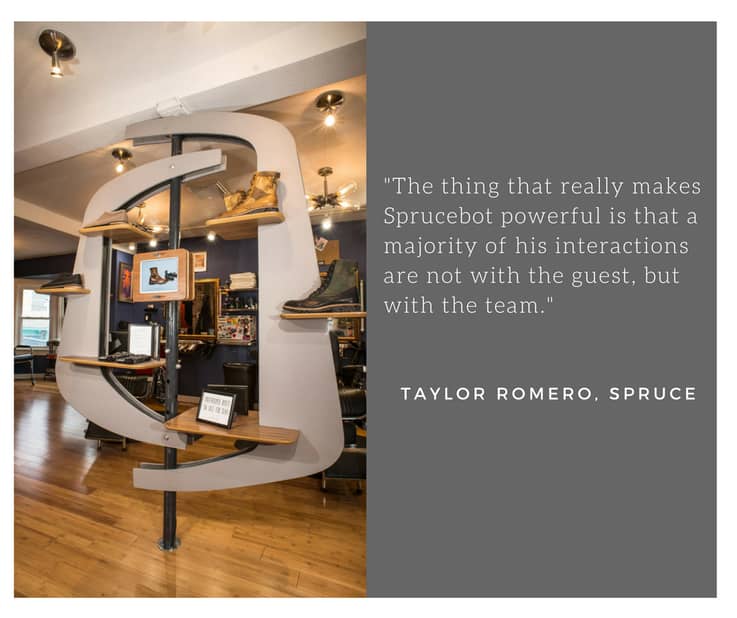
Can skills be made by tweaking other people’s components and recipes?
We won’t have any official policy on that, but if you and other people decided to want to mix and share and collaborate that’s absolutely allowed. Everything from the framework perspective is very discrete. This skill is focused on letting you know when your guest arrives and this skill is focused on helping you take notes and reminding you to take notes at the right time. Now the two skills do work together, so the little black book can feed the alert content. The more skills you turn on you start to get a compounding effect with the value it provides.
One of the biggest complaints about Alexa right now is that skills don’t work together. Our skills work together out of the box because they had to. The thing that’s forced a lot of these decisions wasn’t cool ideas, but was the actual environment, the actual interactions and learning what we really truly needed.
In our case we don’t get to experiment that much, at least right now, because it’s very clear what businesses need and the things they’re asking for. So we have a roadmap laid out for the next 18 months of things that we need to build that aren’t even ideas that anybody’s come up with on their own, but are all things that businesses are continuing to ask for. We know we’re creating value in providing skills.
Are there any brands, agencies or thinkers that really inspire you?
So far I’ve been very surprised with how poor most retail technology is. I would say Jack Dorsey and Square have done a great job at levelling the playing field when it comes to accepting payments and making money.
I think in the technology space, I would say Peter Thiel – it’s funny to listen to him talking because it’s like you said that much better than I could and I’m stealing that. Also, Work Rules! is a book by Laszlo Bock who was Head of People at Google. It’s all focused on the corporate work environment, but still the things that they found with the behaviours that they discovered through micro changes that they made and the ability to collect data are awesome.
Simon Sinek, and his Start With The Why talk, is another. He continues to put out content and ideas that are still groundbreakingly obvious, but that’s what makes them groundbreaking. That’s how I feel about a lot of our retail stuff.
Images courtesy of Spruce.
What happens when retail innovations don’t take off? Find out what this means for future innovation.
Find out more about the latest trends in retail by taking part in one of our Insider Trends retail safaris.

